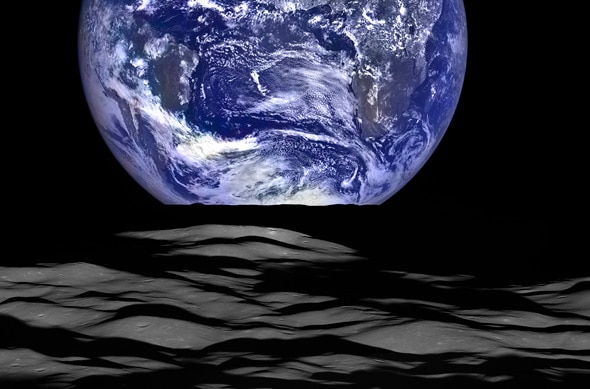Create a free profile to get unlimited access to exclusive videos, sweepstakes, and more!
Earthrise

Just how beautiful is our planet?
This beautiful:
Holy sweet mother of Earth.
This incredible photo was taken by the Lunar Reconnaissance Orbiter, which has been mapping the Moon since it achieved orbit in 2009. Its cameras are usually pointed straight down (what’s called nadir viewing), but sometimes the whole spacecraft is rotated to point them toward the horizon, or even up into space, to measure the Moon’s incredibly thin atmosphere (called an exosphere, which, c’mon, is an extremely cool word) or to take calibration measurements.
In this case, on Oct. 12, 2015, when it took the images used to make this image, LRO was over the large crater Compton, which is just over the visible edge on the farside of the Moon. LRO was 134 km above the Moon’s surface, so it could peek over the horizon and see the Earth.
Note I said, “images.” This is actually a combination of a few separate shots taken by LRO. The high-resolution narrow angle camera (or NAC) only takes grayscale images, while the lower-res wide angle camera (WAC) takes color. Both were used, processed, and combined to make this composite shot.
The commanding sequence performed on LRO was pretty complicated; the NAC is not a two-dimensional camera like your phone cam; it’s actually a single row of pixels that sweeps along its target, reading out the data as quickly as it moves across the target. These data can then be combined to make a 2-D photo. I’ve described how this works before, since it’s a common method in spacecraft.
You can see how they commanded the spacecraft in this nifty animation, where the NAC is represented as a long, skinny red rectangle:
Piece of cake, right? And then they had to figure out how to combine all that data along with that from the WAC to make the spectacular photo above.
So, to be clear, the photo isn’t a snapshot of the Earth as seen from LRO at that moment, but it’s very close to what would’ve been seen had you been riding along with it. Because of that, I have no problem with the integrity of the reality of this image.
And look at it! Our planet is shockingly lush and gorgeous. Especially when compared to the Moon, which is far grayer, and darker, than our blue-green-brown-white world. The contrast is striking.
And two things I have to mention, because they both made me smile. The Earth is almost exactly full in this photo; when LRO took these images the Moon was new, with the Sun almost directly behind it. That means to someone on (or above) the Moon, the Earth was fully lit. It’s very near noon anywhere down the centerline of the Earth in the photo.
The other thing is the Earth’s orientation: North is almost exactly straight up! I had to draw myself a diagram for that one. The picture was taken very near the autumnal equinox, when the North Pole of the Earth is pointed more or less into the direction of its orbit around the Sun. To someone on the Moon’s northern hemisphere, facing the Earth, the North Pole of the planet would be tipped to the left. But LRO was actually at a latitude of about 50° north of the Moon’s equator, and rotated so that the horizon is horizontal. That compensates for the Earth’s tilt, making it look “straight up and down.”
I know, that’s hard to picture; I had to do a lot of drawing and holding up my thumb and tilting my head around, but I think what I’ve described is pretty accurate.
This may seem like needless nit-picking of what is clearly a phenomenal photo, but to me it’s far more than that. There is a real and direct connection between the complicated engineering and implementation of LRO and you. Yes, you. As I write this, the Moon is at first quarter. In a week it’ll be full (on Christmas Eve), and every night between now and then you can go out and watch the phase change, watch new details come into view. Millennia ago, our ancestors started to grasp the nature of the passing of time, and after the day/night cycle, the phases and location of the Moon were the next obvious cycle to notice. It was such a basic unit of time that we incorporated it into our calendar as months. Where do you think that word came from, anyway?
Our lives may seem disconnected from the sky these days, but that is an illusion, a contempt bred from familiarity. We are in fact deeply connected to the sky, you and me. All of us. The next time you look up at the Moon, remember this photo, taken from the Moon looking back at all of us, and remember that connection.














